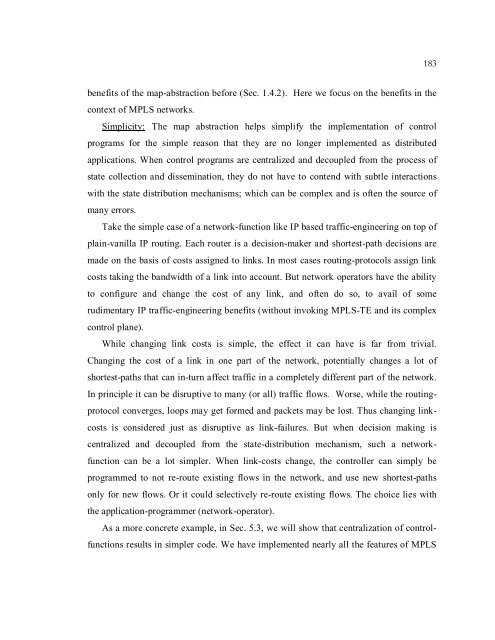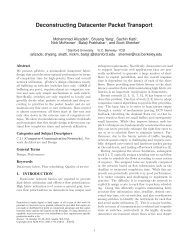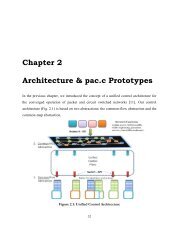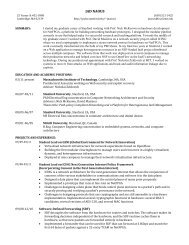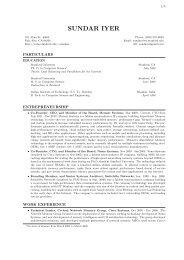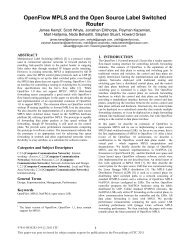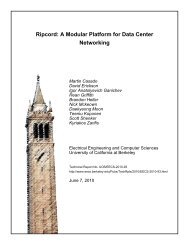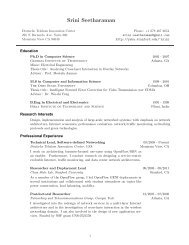Chapter 5 Introducing SDN Control in MPLS Networks - High ...
Chapter 5 Introducing SDN Control in MPLS Networks - High ...
Chapter 5 Introducing SDN Control in MPLS Networks - High ...
You also want an ePaper? Increase the reach of your titles
YUMPU automatically turns print PDFs into web optimized ePapers that Google loves.
183benefits of the map-abstraction before (Sec. 1.4.2). Here we focus on the benefits <strong>in</strong> thecontext of <strong>MPLS</strong> networks.Simplicity: The map abstraction helps simplify the implementation of controlprograms for the simple reason that they are no longer implemented as distributedapplications. When control programs are centralized and decoupled from the process ofstate collection and dissem<strong>in</strong>ation, they do not have to contend with subtle <strong>in</strong>teractionswith the state distribution mechanisms; which can be complex and is often the source ofmany errors.Take the simple case of a network-function like IP based traffic-eng<strong>in</strong>eer<strong>in</strong>g on top ofpla<strong>in</strong>-vanilla IP rout<strong>in</strong>g. Each router is a decision-maker and shortest-path decisions aremade on the basis of costs assigned to l<strong>in</strong>ks. In most cases rout<strong>in</strong>g-protocols assign l<strong>in</strong>kcosts tak<strong>in</strong>g the bandwidth of a l<strong>in</strong>k <strong>in</strong>to account. But network operators have the abilityto configure and change the cost of any l<strong>in</strong>k, and often do so, to avail of somerudimentary IP traffic-eng<strong>in</strong>eer<strong>in</strong>g benefits (without <strong>in</strong>vok<strong>in</strong>g <strong>MPLS</strong>-TE and its complexcontrol plane).While chang<strong>in</strong>g l<strong>in</strong>k costs is simple, the effect it can have is far from trivial.Chang<strong>in</strong>g the cost of a l<strong>in</strong>k <strong>in</strong> one part of the network, potentially changes a lot ofshortest-paths that can <strong>in</strong>-turn affect traffic <strong>in</strong> a completely different part of the network.In pr<strong>in</strong>ciple it can be disruptive to many (or all) traffic flows. Worse, while the rout<strong>in</strong>gprotocolconverges, loops may get formed and packets may be lost. Thus chang<strong>in</strong>g l<strong>in</strong>kcostsis considered just as disruptive as l<strong>in</strong>k-failures. But when decision mak<strong>in</strong>g iscentralized and decoupled from the state-distribution mechanism, such a networkfunctioncan be a lot simpler. When l<strong>in</strong>k-costs change, the controller can simply beprogrammed to not re-route exist<strong>in</strong>g flows <strong>in</strong> the network, and use new shortest-pathsonly for new flows. Or it could selectively re-route exist<strong>in</strong>g flows. The choice lies withthe application-programmer (network-operator).As a more concrete example, <strong>in</strong> Sec. 5.3, we will show that centralization of controlfunctionsresults <strong>in</strong> simpler code. We have implemented nearly all the features of <strong>MPLS</strong>


